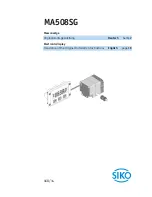
22
Instruction Booklet
IB02201004E
Effective October 2017
Revision #4
Instructions for installation, operation, and
maintenance of 38 kV type VacClad-W,
150 BIL switchgear indoor housings
EATON
www.eaton.com
6 . Release the lifter brake by stepping down on the brake
release (see Figure 27) .
7 . Pull back on the pan safety latch release lever (see Figure 31)
to release the safety latches and the pan from the compart-
ment . Pull the lifter out and away from the switchgear unit .
Figure 31. Releasing the Lifter Pan and Lifter from the Auxiliary
Compartment.
E . Removing the transformer drawer from the auxiliary compartment:
1 . Follow “A” in this section to secure the lifter pan to the lifter .
2 . Maneuver the lifter inline with the front of the switchgear so
that each side of the lifter pan will clear the switchgear side
sheets when the pan is moved into place .
3 . Push the lifter with pan up against the front of the switchgear
section (See Figure 28) . The pan guide-stops will guide the
pan into the compartment and align the pan rails into the
correct position with the compartment guide rails . The guide-
stops butt up against the switchgear side sheets and prevent
the lifter from moving too far into the compartment . As the
pan is moved into place, the pan safety latches bias off the
switchgear side sheets and latch to the side sheet flanges
when the pan is fully in place . These safety latches, along
with the lifter brake, prevent the lifter and pan from backing
out of the compartment when the drawer is moved in and
out of the compartment .
4 . Lower the lifter pan by rotating the winch counterclockwise
until the pan rests on the compartment floor sheet . For an
upper compartment, only the front of the pan will rest on the
floor of the compartment . In any case, make sure the lifter
block remains in the pan bracket (see Figure 24) and the pan
is level with the compartment floor .
5 . Lock the lifter in place by stepping down on the lifter brake
pedal (Figure 25) .
6 . With the transformer drawer in the Disconnect position and
the drawer in the fully retracted position (see Figure 9), stand
to one side of the lifter (opposite the front switchgear door
hinges), reach into the compartment, and pull firmly on the
red drawer release lever (see Figure 7) to release the trans-
former drawer from the cell .
7 . Pull the drawer, using the red release lever, onto the lifter
pan, making sure that the wheels on the drawer roll on the
pan between the pan rails . Pull the drawer all the way back
on the pan and up against the rubber stops .
NOTICE
DO NOT HANDLE THE FUSE TUBES AND MATING PARTS WHILE MOVING
THE TRANSFORMER DRAWER. THIS MAY CAUSE DAMAGE TO THESE
PARTS.
8 . Make sure the drawer safety latch has secured the drawer to
the lifter pan (see Figure 26) . The safety latch hitches to the
underside of the drawer flange . Push on the drawer to con-
firm it is fixed to the pan .
9 . With the transformer drawer fixed to the lifter pan, return to
the rear of the lifter and crank the lifter winch clockwise a
few turns until the pan comes off the compartment floor a
small distance .
CAUTION
PERFORMING #11 BELOW BEFORE PERFORMING #9 ABOVE WILL CAUSE
THE LIFTER PAN TO SUDDENLY DEFLECT WITH AN UNDESIRABLE IMPACT
LOADING AS THE LIFTER WITH PAN IS MOVED AWAY FROM THE SUPPORT
OF THE COMPARTMENT FLOOR. THE DRAWER WEIGHT ON THE PAN
CAUSES A SMALL CANTILEVER DEFLECTION ON THE PAN SUPPORTS
WHEN FREE FROM SUPPORT OF THE COMPARTMENT FLOOR.
10 . Release the lifter brake by stepping down on the brake
release (see Figure 27) .
11 . Pull back on the pan safety latch release lever (see Figure 31)
to release the safety latches and the pan from the compart-
ment . Pull the lifter out and away from the switchgear unit .
9.2.3 Manual ground and test device
The manual ground and test device, shown in Figure 32, consists of
a drawout element that can be inserted into a circuit breaker com-
partment in the same manner as the drawout vacuum circuit breaker
element . The device includes six terminals and ground bus connec-
tions . Each terminal is isolated from each other and the bus connec-
tion by insulating the respective front panel . The ground connection
is located in the lower front section of the device . The grounding
of either upper or lower terminals is accomplished by connecting
grounding links (provided with the device) from either the upper or
the lower terminals to the device ground connection . Cable testing
or “phasing out” testing may be accomplished by connecting suit-
able test equipment as required, to the terminals .
Because the grounding and test device has no making or interrupting
ability, the circuits must be de-energized before the ground is con-
nected or removed .
Refer to IL3A74795 for complete instructions for this device . Read
them fully before using the device .







































